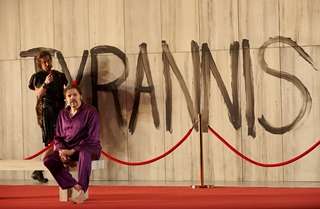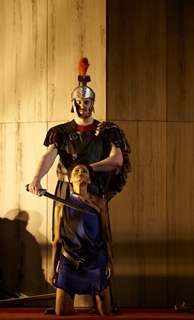|
Back
Bliss and exasperation Toronto
The Four Seasons Centre for the Performing Arts
02/03/2013 - & February 6*, 7, 9, 11, 13, 16, 19, 22, 2013
Wolfgang Amadeus Mozart: La clemenza di Tito, K. 621
Michael Schade (Tito), Isabel Leonard (Sesto), Keri Alkema (Vitellia), Wallis Giunta (Annio), Mireille Asselin (Servilia), Robert Gleadow (Publio)
The Canadian Opera Company Chorus, Sandra Horst (Chorus Master), The Canadian Opera Company Orchestra, Daniel Cohen (Conductor)
Christopher Alden (Director), Andrew Cavanaugh Holland (Set Designer), Terese Walden (Costume Designer), Gary Marder (Lighting Designer)

R. Gleadow & M. Schade (© Michael Cooper)
There are good reasons Mozart’s La clemenza di Tito was ignored by opera companies for 150 years or so - the dry-as-dust recitatives and flimsily-motivated characters seemed at odds with the superb arias and ensembles. And wasn’t opera seria really just an old, dead thing? Christopher Alden’s production, first seen at Chicago Opera Theater in 2009, seems to be an attempt to modernize (or post-modernize?) the work, but its grab-bag of sight gags and whims, accompanied by Gary Marder’s glaring lighting, creates nothing but a frustrating jumble.
Musically the piece ranges from just fine to absolutely terrific. The singers are all extremely well-suited to the roles (we’re happily getting used to this thanks to Alexander Neef’s astute casting). Young Israeli conductor Daniel Cohen, making his local debut, handles it all very nicely. Outstanding orchestral players include Stephen B. Hargreaves on the fortepiano and James T. Shields on the basset horn.
The central figure is the conflicted Sesto - starrily voiced and acted by the rising mezzo Isabel Leonard - but he spends much of his time lurking behind a shiny trash can (uh-oh, did I just use the word “trash”?)
To differentiate Sesto from the other mezzo’s trouser (actually tunic) role, Wallis Giunta as Annio is portrayed a bespectacled jogger, constantly doing his stretches. Fortunately this doesn’t prevent her from delivering some very fine singing, notably “Torna di Tito a lato” at the beginning of Act II.
One must give Michael Schade full credit for seizing onto a concept (or konzept) and taking it to its full limits, if not beyond. His Tito, clad in purple pyjamas until the final scene when in golden armour, is a twitchy neurasthenic, professing fine sentiments when not manhandling his subordinates. One low point is when, just after their brief engagement, he forcibly examines Servilia’s teeth. (Really!)
Tito’s captain of the guard, Publio, is portrayed as a doofus in a Halloween Roman legionnaire outfit; the attempts at humour undercut the thoughtful sentiments of his only aria.
Mireille Asselin’s Servilia is an alluring figure right out of a Botticelli painting. She and Annio are compelled inexplicably to fall flat on the floor on two occasions.
This leaves only Vitellia, the self-absorbed femme fatale with absolutely no sense of impulse control. This is one of Mozart’s soprano roles that calls for great dips into the lower vocal ranges (like Fiordiligi in Cosi fan tutte). Keri Alkema accomplishes this well - while, along the way, vomiting into the trash receptacle then, after contritely confessing her (major) role in the plot to kill the emperor, spitting in Tito’s face. (It’s innovative all right!)
The chorus members dressed in cheap-looking modern clothes all wear kerchiefs (women and men) plus face half-masks. I think this means they are the faceless rabble of ancient Rome (and modern anywhere). It’s best when we don’t see them, as when they sing from a gallery above the proscenium. Of course they sing well (as usual).
Tito has a red telephone for sending out his orders. The opera as written calls for him to sign Sesto’s death warrant, then tear it up. But here he makes the command over the telephone and is not seen to rescind it. This counters the theme of clemency, but I think we are to believe that Tito’s clemency is really an example of repressive tolerance.
Overall, Alden has taken a difficult work and made it impossible to fathom. This is his fourth production for the COC: his Die Fledermaus last fall simply lacked fun and his Rigoletto (2011) was wrong-headed. I almost regret praising his Der Fliegende Holländer (last seen in 2010 in its third go-round). Better luck next time, if there is a next time.

N. Craighead & R. Chaieb (© Michael Cooper)
The Feb 6 performance featured members of the COC’s Ensemble Studio in the main roles: Ambur Braid (Vitellia), Rihab Chaieb (Sesto), Sasha Djihanian (Annio), Neil Craighead (Publio), Claire de Sevigné (Servilia), and two tenors, Christopher Enns and Owen McCausland, sharing the role of Tito. The company used to stage an annual showcase production in a smaller venue for the young artists, but this is the fourth year when they have been assigned a single performance of a main stage production (the previous three were Idomeneo, Die Zauberflöte, and Semele; next season: Cosi fan tutte).
Once again, the wisdom of the policy was brilliantly borne out. While there is a greater sense of sheer amplitude (or “performance muscle”) in the main cast’s performance, the studio members held their own extremely well. (The two mezzo-sopranos were especially good). For anyone who hasn’t attended one of these special performances, watch out for the one next season.
Michael Johnson
|